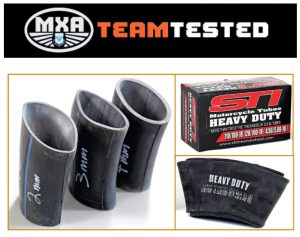“This Is The Tube You Should Run.” MXA Test
 The Motocross Action magazine test crew spent some quality time with STI motorcycle inner tubes recently, and said, “If you are looking to avoid a flat tire, this is the tube you should run.” You want the complete story? Check it out below, or read it on motocrossactionmag.com.
The Motocross Action magazine test crew spent some quality time with STI motorcycle inner tubes recently, and said, “If you are looking to avoid a flat tire, this is the tube you should run.” You want the complete story? Check it out below, or read it on motocrossactionmag.com.
WHAT IS IT? There is nothing worse for a motocross racer than a flat tire. Not only is your moto over, but you have to change the tube. When this happens to the MXA wrecking crew—and it does with some regularity, especially on KTMs, which come with paper-thin Pirelli lightweight tubes—we install STI Heavy Duty inner tubes. Not only are they twice as thick as a standard tube, but they are incredibly affordable.
WHAT’S IT COST? $12.95 (Heavy Duty rear),$9.95 (Heavy Duty front).
CONTACT? Your friendly local dealer can order them from MTA Distributing.
WHAT STANDS OUT? Here’s a list of things that stand out with STI Heavy Duty inner tubes.
(1) STI tubes. STI inner tubes come in three different thicknesses: Heavy Duty (2mm thick), Extreme Duty (3mm thick) and Ultra Heavy Duty (4mm thick). We readily admit that we would never use an STI Extreme Duty or Ultra Heavy tube for racing because they would be overkill. The 3mm-thick Extreme Duty is best for Baja, desert racing, WORCS or GNCC, while the 4mm-thick Ultra Heavy Duty tube is so rugged that it’s best for 950cc adventure bikes (since a flat tire high in the Rockies could mean a night with the bears).
(2) Pricing. Have you priced inner tubes lately? MXA browsed the marketplace and found that heavy-duty tubes from Michelin, Bridgestone and Pirelli vary from $25 to $36. Worse yet, a bib mousse (a solid-foam tube) runs well over $100. This is why STI is a lifesaver; its Heavy Duty tube is only $12 (less than the price of a regular replacement inner tube).
(3) Solution. STI does not make regular tubes. STI specializes in making thicker-than-stock heavy-duty tubes—and sales have rocketed up every month because so many people are looking for a flat-tire solution. The typical OEM tube is 0.8mm to 1mm thick. Manufacturers choose this type of tube for production-line use because it is both light and inexpensive to spec. STI tubes are anywhere from twice as thick to four times as thick. For example, the STI Heavy Duty tube is made from butyl rubber with a 2mm thickness. We originally started testing STI Heavy Duty inner tubes back in 2013 just to ensure that a test or photo session wouldn’t be ruined by an unexpected flat tire. We have run them ever since. They have a good track record—but there are lots of things that can damage rubber.
(4) Weight. STI’s Heavy Duty tube is heavier than a regular tube. How much heavier? Our 110/90-19 Heavy Duty model was exactly 1 pound heavier than an OEM 1mm-thick tube. The extra weight is not exactly a performance enhancer, but neither is a flat tire. Sometimes you have to play it safe.
WHAT’S THE SQUAWK? The weight is a negative, especially since it is unsprung, but for the average local racer, the weight of the STI Heavy Duty tube is offset by the added dose of confidence.
MXA RATING: If you are looking to avoid a flat tire, this is the tube you should run. Ryan Dungey and Ken Roczen don’t need heavy-duty tubes, but they don’t pay their own entry fees or change their own tires, either.



